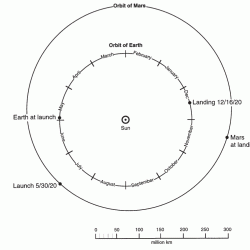Source Institutions
Source Institutions
Add to list Go to activity
Activity link broken? See if it's at the internet archive

In this two-part activity, learners map a navigation plan to get from Earth to Mars and back. In activity one, learners represent the orbital paths of Earth through dance and dramatic movement. In activity two, learners working in pairs plot the paths (trajectories) of a spacecraft traveling between Earth and Mars in the year 2018 and returning in 2020, while using the minimum amount of fuel. This lesson guide includes background information, suggested questions, answer keys, and handouts.
- 10 to 30 minutes
- 45 to 60 minutes
- 1 cent - $1 per group of students
- Ages 8 - 18
- Activity, Lesson/Lesson Plan, Simulation
- English
Quick Guide
Materials List (per group of students)
- Student Procedure Handouts: Dancing with the Planets (p. 7 of PDF)
- costume and prop materials as needed
- Student Procedure Handouts: Plotting the Paths of Spacecraft (p. 8 of PDF)
- Student Sheets: Earth to Mars and Mars to Earth (p. 9-10 of PDF)
- pencils
- drawing compass
- Teacher Answer Key (pgs. 5-6)
Subjects
-
Earth and Space Science
-
Astronomy
- Probes, Satellites and Spacecraft
- Earth, Moon and Sun
-
Solar System
- The Sun
- The Planets
-
Astronomy
-
Engineering and Technology
-
Engineering
- Aerospace Engineering
-
Engineering
-
Mathematics
-
Algebra
- Patterns
-
Data Analysis and Probability
- Data Analysis
- Data Collection
- Data Representation
- Probability
-
Geometry
- Plane Geometry
-
Measurement
- Units of Measurement
- Circles
- Rate
- Number and Operations
-
Algebra
-
The Nature of Technology
-
Technology and Society
- Impacts of Technology
-
Technology and Society
-
Physical Sciences
-
Motion and Forces
- Projectile Motion
-
Motion and Forces
-
The Nature of Science
-
Science and Society
- Risks and Benefits
-
The Scientific Process
- Conducting Investigations
- Gathering Data
- Formulating Explanations
- Communicating Results
- Science as a Career
-
Science and Society
Informal Categories
- Performing Arts
- Physical Activity
- Transportation
Audience
To use this activity, learners need to:
- see
- read
- hear
- be mobile
- touch
Learning styles supported:
- Involves teamwork and communication skills
- Links STEM to other topics of interest such as arts and humanities
- Involves hands-on or lab activities
Other
This resource is part of:
Access Rights:
- Free access
By:
- Astromaterials Research and Exploration Science (ARES), NASA-Lyndon B. Johnson Space Center; Burke Baker Planetarium, Houston Museum of Natural Science
Rights:
- Public domain, ,
